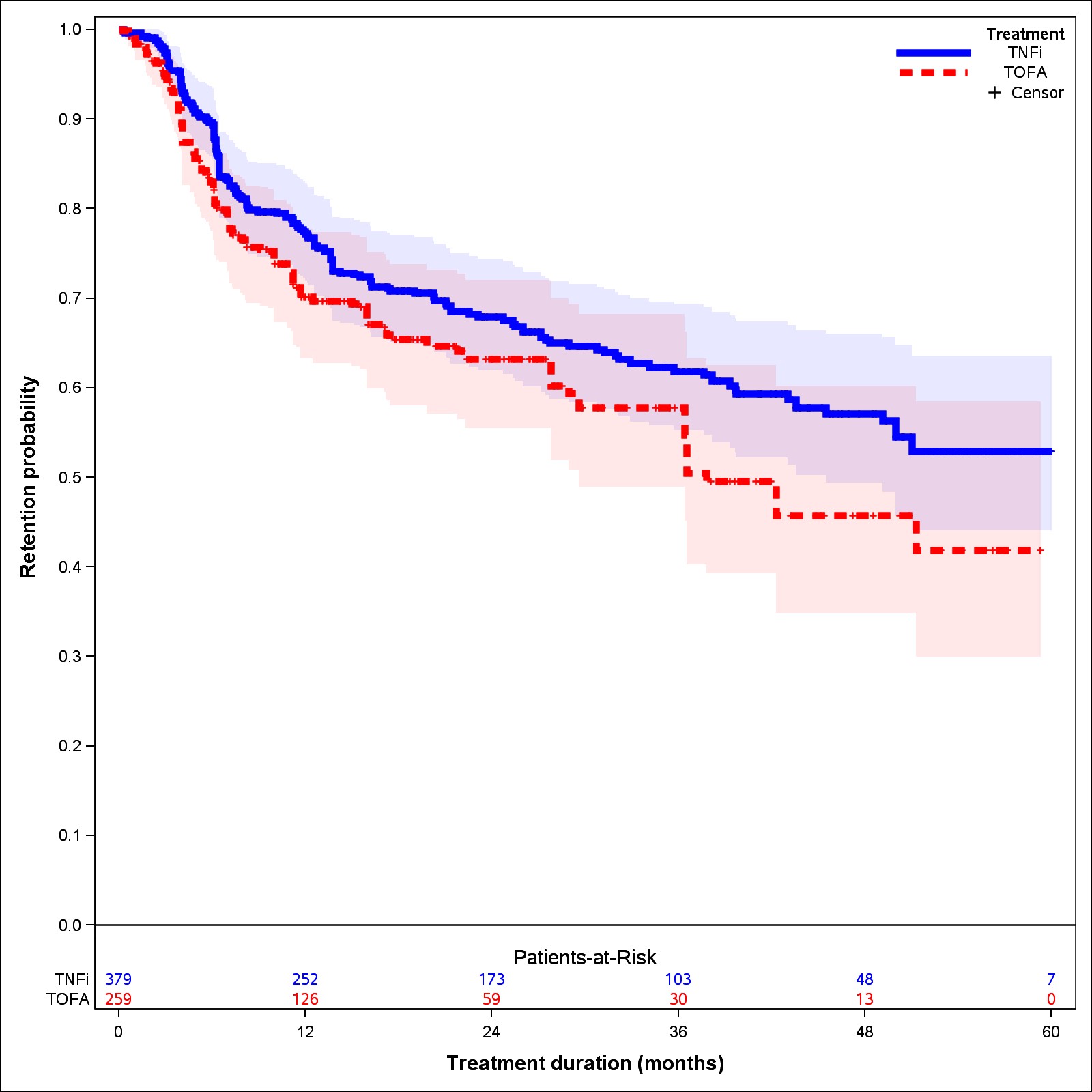Session Information
Date: Saturday, November 7, 2020
Title: RA – Treatments Poster II: Comparative Effectiveness, Biosimilars, Adherence & the Real World
Session Type: Poster Session B
Session Time: 9:00AM-11:00AM
Background/Purpose: Tofacitinib (TOFA) is an oral, small molecule drug used for rheumatoid arthritis (RA) treatment and is prescribed alone or with methotrexate (MTX). TOFA can be used as an alternative to biologic disease modifying antirheumatic drugs (bDMARDs) including tumor necrosis factor inhibitors (TNFi). We aimed to evaluate the discontinuation rate of TNFi compared to TOFA, in patients with RA in the Ontario Best Practices Research Initiative (OBRI).
Methods: RA patients enrolled in the OBRI initiating their TOFA or TNFi (adalimumab, certolizumab, etancercept, golimumab, and infliximab) between 1st June 2014 (TOFA approval date in Canada) and 31st Dec 2019 were included. Time to discontinuation were assessed using adjusted Kaplan-Meier (KM) survival and Cox regression models. To deal with confounding by indication, we estimated propensity scores for selected covariates with a standard difference greater than 0.1. We then adjusted models by applying stratification and inverse probability of treatment weight (IPTW) methods to compare discontinuation of TNFi versus TOFA. Multiple imputation (N=20) was used to deal with missing data for covaraites at treatment initiation.
Results: A total of 721 patients initiated TNFi (n=417) or TOFA (n=304) with mean (SD) disease duration of 8.9 (9.0) and 13.6 (9.6) years, respectively. In the TNFi group 82% were female and mean age (SD) at treatment initation was 57.0 (13) years. In the TOFA group, 85% were female and mean (SD) age at treatment initation was 60.7 (11) years. The TNFi group was less likely to have prior biologic use (22%) compared with the TOFA group (66%). At treatment initiation, the mean (SD) 28-swollen joint counts was siginificantly lower in the TNFi group [4.8 (4.0)] compared to the TOFA group [5.7 (4.4)]. Physical function measured by HAQ-DI was also significantly lower in TNFi compared to the TOFA group (1.1 vs.1.3).
Over a mean of 20.3 month follow-up, discontinuation was reported in 134 (32.1%) and 108 (35.5%) of all TNFi and TOFA patients, respectively. After adjusting for propensity score across 20 imputated datasets, there was no significant difference in discontinuation between treatment groups (adjusted HRs: 0.80, 95% CI: 0.60-1.05; p=0.11). The results were similar for two propensity adjustment methods. Figure 1 shows IPTW adjusted KM survival curves comparing discontinuation rates in patients treated with TNFi and TOFA.
Conclusion: In this real world data study, we found that TNFi and TOFA retention is similar in patients with RA. Merging data with other RA registries in Canada is proposed to increase study power and to provide more robust results.
 Figure 1. IPTW adjusted KM survival curves comparing discontinuation rates in patients treated with TNFi and TOFA.
Figure 1. IPTW adjusted KM survival curves comparing discontinuation rates in patients treated with TNFi and TOFA.
To cite this abstract in AMA style:
Movahedi M, Cesta A, Li X, Keystone E, Bombardier C. Discontinuation Rate of Tofacitinib Is Similar When Compared to TNF Inhibitors in Rheumatoid Arthritis Patients: Real World Results from a Rheumatoid Arthritis Cohort [abstract]. Arthritis Rheumatol. 2020; 72 (suppl 10). https://acrabstracts.org/abstract/discontinuation-rate-of-tofacitinib-is-similar-when-compared-to-tnf-inhibitors-in-rheumatoid-arthritis-patients-real-world-results-from-a-rheumatoid-arthritis-cohort/. Accessed .« Back to ACR Convergence 2020
ACR Meeting Abstracts - https://acrabstracts.org/abstract/discontinuation-rate-of-tofacitinib-is-similar-when-compared-to-tnf-inhibitors-in-rheumatoid-arthritis-patients-real-world-results-from-a-rheumatoid-arthritis-cohort/
